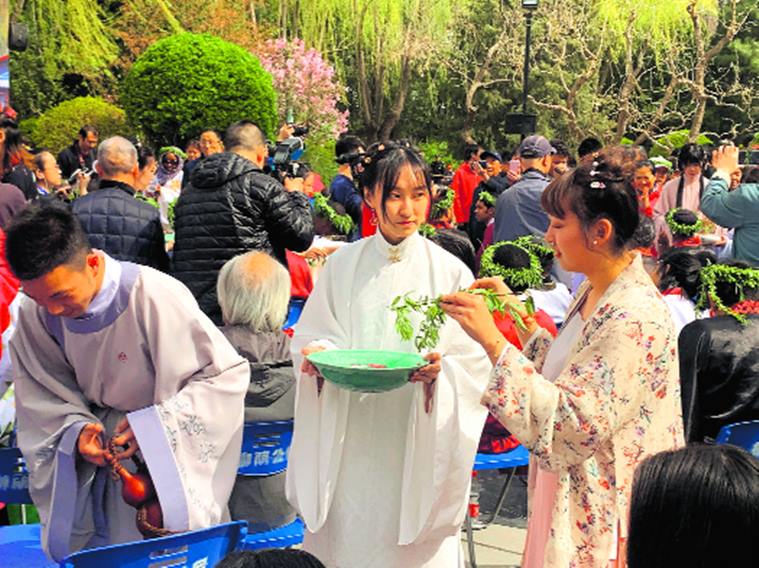
Xiao Yuan, 25, in a jeans, T-shirt and a loose sweatshirt, says if she misses her grandpa, she just drives over to his tomb. She doesn’t need the Qingming Festival to remember him by. “I don’t really believe in all this,” she says casually, with a camera slung over her shoulder, as she shouts instructions to foreigners on how to plant a willow the right way.
Friday, April 5, was the Qingming Festival or the Tomb Sweeping Day in China, and as the name suggests, it is a day to visit family members who have passed, sweep their tombs, make offerings of food they enjoyed and maybe even burn paper iPhones, paper cars, and paper “hell money” — fake RMB which, if it burns right through, signifies that Yuan’s grandfather received some pocket money.
Yuan and I stood chatting next to a freshly dug plot of land where little Chinese children in frilly frocks and foreigners in Hanfus, poked cylindrical willow shoots into the ground and posed for photographs. I was in a Hanfu, too, a bright red skirt, white top, and a red belt that kept it all together. I could have been mistaken to be part of China’s “Hanfu movement” dedicated to, as the New York Times puts it, “reviving the clothes they believe China’s Han ethnic majority wore before their country succumbed to centuries of foreign domination.” In recent months, China has been pushing for revival of traditional virtues, but with the Hanfu there has been some debate over how much it can be modified to meet modern tastes with people even pushing for a back pocket to store their phones and cigarettes in.
At the Liuying or Willow Park that morning, Yuan ran through a mini-Mandarin lesson. “In Chinese, liu which means willow has a similar pronunciation to liú which means ‘to stay’,” she said. In other words, in the four-tones of the Mandarin language, “that is tone 2 and tone 3,” she said about the intonation, “If we plant the willow, it is like we want them to stay.”

Ahead of this planting ceremony, the stage less than half-a-kilometre away was occupied by a woman, who offered the morning’s agenda with much excitement. Chinese men, women and children, and a bus load of foreigners in Hanfus and willow wreaths over their head, watched a song and dance show, and recitation of ‘Willow Appreciation Poems’, about which my Mandarin teacher, who was present, simply said: “These are poems which you learn in primary school. It is difficult to translate.”
On the eve of Tomb Sweeping Day, China’s English language news channel, CGTN, ran a multiple choice poll asking what people do on this important traditional festival which is a “solar term” on the Chinese lunar calendar. The options: eat dumplings, watch a dragon boat race, sweep tombs or hike up hills. While years ago, Chinese citizens were invited to mourn online at a new Beijing government platform to commemorate martyrs who died fighting Japan between 1937 and 1945, China Daily reported leading up to Tomb Sweeping Day, that the remains of 10 Chinese soldiers who died in the 1950-53 Korean War arrived in Shenyang in Liaoning Province.
I went on WeChat to find my friend Zhou Xin, the Chinese woman who teaches Tamil here, to ask her what happens on this day. “In South China, people eat qingtuan (a green dumpling made of glutinous rice). We don’t really eat anything special on Qingming,” she said.
Back at the park, 11-year-old Meng Xinyuan walked over to me and asked in English if she could take a picture with me. Meng has been in Bolivia for three years, studying English, she told me. I asked her mother, through the little girl, where Chinese people believed people went after they died. What does the afterlife look like? “Somewhere beautiful, with an abundance of food and where the air is definitely better than Beijing,” she smiled.
This article appeared in print with the headline ‘Death’s End’